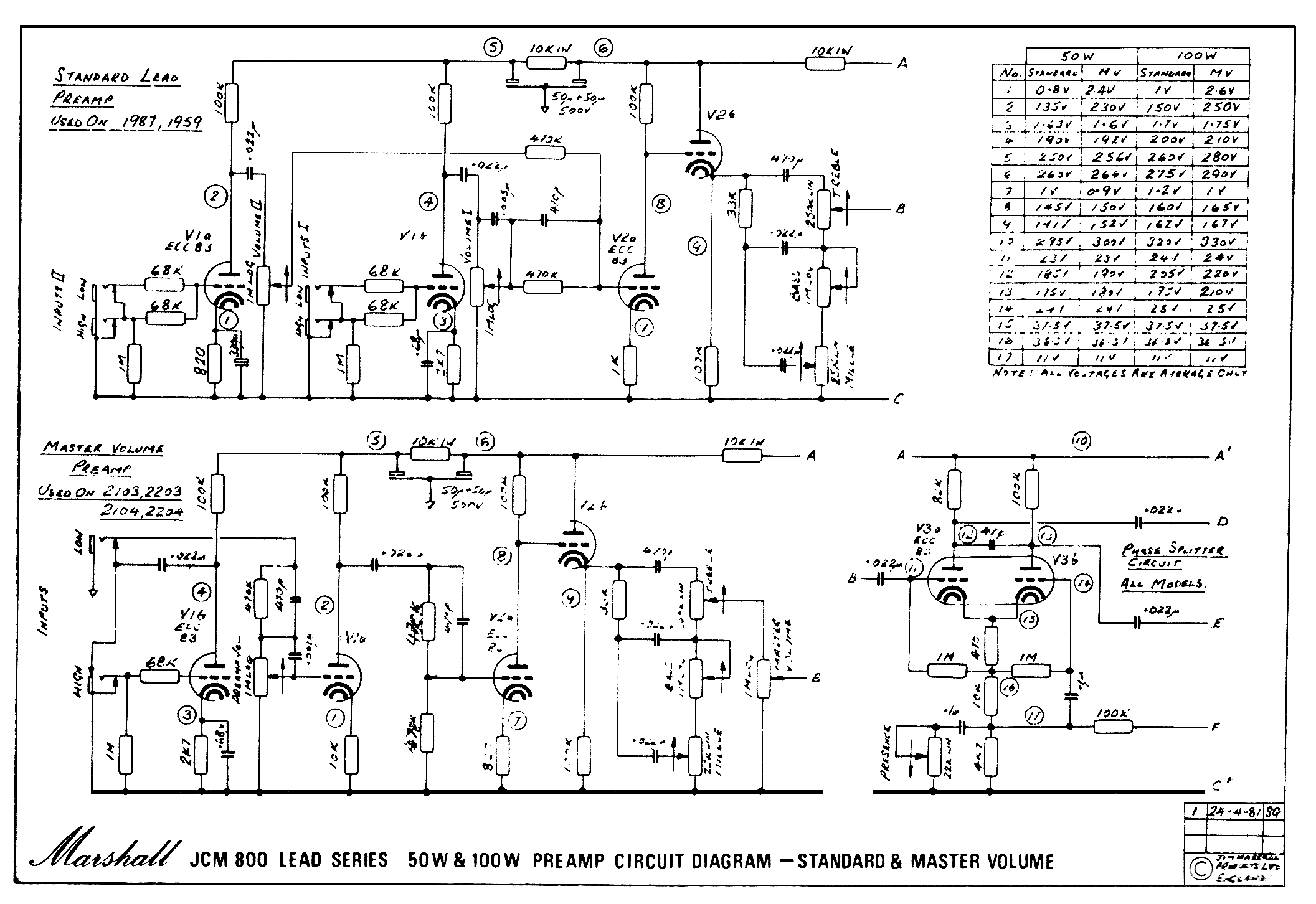Matador
Well-known member
Can anyone think of a reason why a stock Marshall 2203 (JCM800 from the mid 80's) would break into oscillation with a simple mod?

The mod is essentially adding a 0.1uF bypass cap across the 10K cold-clipper cathode resistor on V1A. Without the cap, the amp works normally. When the cap is added, even without a guitar plugged in (shorting jack), V1A screeches like a banshee at about 860Hz when the preamp volume pot is increased anything past 2 o'clock (leading into V1A).
Things I've tried:
a) Adding a 68K grid stopper directly to pin 2 on V1A - no effect
b) Shunting across V1B's plate resistor with a 220p cap to reduce high frequency gain in the front end - wailing is slightly quieter, but still happens.
c) Adding a small (47pF) plate to grid feedback cap in V1A - this stops the oscillation, however the tone of the amp drastically shifts to be less bright in overdrive tones.
d) Adding a blank plug into the low jack (breaking the connection between the first two gain stages) and the wailing stops
e) In creasing the 10K filter resistance in the power supply to lower the supply voltage going to the first two stages (from 10K to 27K): no difference
f) Half a dozen different tubes in the V1 position (even a 12AY7) all do the same thing, although the frequency of the screeching shifts slightly (between 750Hz and 900Hz) depending on the tube
g) Running a signal into the lock jack, and the amp works normally, just at less gain.
Any ideas? Obviously there is some parasitic feedback path that might just be on the edge with the stock circuit, that the added gain of the bypass on V1A is causing the amp to oscillate. The interaction must be between the first two stages. However none of these values are outside the range that I have seen in other high(ish) gain amps like the SLO, Rev, or Mesa's.

The mod is essentially adding a 0.1uF bypass cap across the 10K cold-clipper cathode resistor on V1A. Without the cap, the amp works normally. When the cap is added, even without a guitar plugged in (shorting jack), V1A screeches like a banshee at about 860Hz when the preamp volume pot is increased anything past 2 o'clock (leading into V1A).
Things I've tried:
a) Adding a 68K grid stopper directly to pin 2 on V1A - no effect
b) Shunting across V1B's plate resistor with a 220p cap to reduce high frequency gain in the front end - wailing is slightly quieter, but still happens.
c) Adding a small (47pF) plate to grid feedback cap in V1A - this stops the oscillation, however the tone of the amp drastically shifts to be less bright in overdrive tones.
d) Adding a blank plug into the low jack (breaking the connection between the first two gain stages) and the wailing stops
e) In creasing the 10K filter resistance in the power supply to lower the supply voltage going to the first two stages (from 10K to 27K): no difference
f) Half a dozen different tubes in the V1 position (even a 12AY7) all do the same thing, although the frequency of the screeching shifts slightly (between 750Hz and 900Hz) depending on the tube
g) Running a signal into the lock jack, and the amp works normally, just at less gain.
Any ideas? Obviously there is some parasitic feedback path that might just be on the edge with the stock circuit, that the added gain of the bypass on V1A is causing the amp to oscillate. The interaction must be between the first two stages. However none of these values are outside the range that I have seen in other high(ish) gain amps like the SLO, Rev, or Mesa's.



